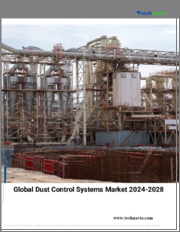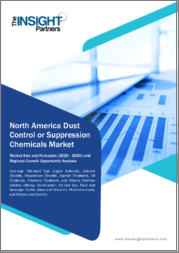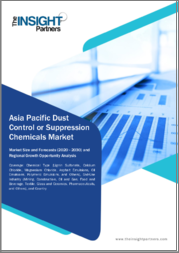
|
시장보고서
상품코드
1621726
더스트 컨트롤 시스템 시장 기회, 성장 촉진요인, 산업 동향 분석, 예측(2024-2032년)Dust Control Systems Market Opportunity, Growth Drivers, Industry Trend Analysis, and Forecast 2024 - 2032 |
||||||
세계의 더스트 컨트롤 시스템 시장은 2023년에 167억 달러로 평가되며, 2024-2032년 CAGR 4.4%로 성장할 것으로 예측됩니다.
이 성장의 주요 요인은 전 세계 산업 및 건설 활동 증가에 기인합니다. 첨단 먼지 억제 기술을 채택함으로써 기업은 운영 효율성을 유지하면서 환경에 미치는 영향을 줄일 수 있습니다. 건강 및 환경 문제에 대한 인식이 높아지면서 규제 준수에 대한 필요성과 함께 혁신적인 먼지 억제 솔루션에 대한 수요가 증가하고 있습니다. 산업이 확장되고 현대화됨에 따라 지속가능한 관행에 대한 관심은 비즈니스 전략의 필수 컴포넌트로서 먼지 제어 시스템의 중요성을 강화하고 있습니다.
먼지 제어 시스템 시장은 습식 및 건식 시스템으로 분류되며, 습식 시스템이 큰 매출을 창출하고 있습니다. 습식 먼지 제어 솔루션은 수분을 적용하여 공기 중의 입자를 효과적으로 억제할 수 있는 능력으로 인해 선호되고 있습니다. 이러한 시스템은 물 또는 화학 혼합물을 사용하여 먼지를 포집하여 먼지가 공기 중에 떠다니는 것을 방지하고 잠재적인 건강 위험을 줄입니다. 또한 습식 방식은 정비 빈도가 적고 건설 및 채광과 같은 대규모 작업에서 비용 효율성이 높은 경향이 있습니다.
다양한 환경 조건에서 대량의 먼지를 효율적으로 관리할 수 있는 습식 방식은 다양한 분야에서 선택되고 있습니다. 이동성 측면에서 이동식 컨트롤러 부문은 적응성과 사용 편의성으로 인해 시장에서 큰 점유율을 차지하고 있습니다. 이러한 시스템은 다양한 현장으로 쉽게 운반할 수 있으며, 변화하는 먼지 제어 수요에 유연하게 대응할 수 있습니다. 원격지나 손이 닿지 않는 곳에서도 효과적으로 작동할 수 있으며, 전반적인 작업 효율을 향상시키고 다양한 용도에 적합합니다.
| 시장 범위 | |
|---|---|
| 개시년 | 2023년 |
| 예측년 | 2024-2032년 |
| 개시 금액 | 167억 달러 |
| 예측 금액 | 245억 달러 |
| CAGR | 4.4% |
또한 모바일 컨트롤러는 자동 먼지 모니터링 및 스프레이 제어와 같은 첨단 기술을 자주 통합하여 그 효과와 시장 매력을 높이고 있습니다. 2023년에 40억 달러로 평가되는 미국의 더스트 컨트롤 시스템 시장은 엄격한 환경 규제와 직장의 안전성에 대한 관심 증가의 영향을 받고 있습니다. 다양한 산업이 공기중 입자상 물질의 배출을 최소한으로 억제하는 것을 목적으로 한 연방과 주의 요건을 충족하기 위해 첨단 방진 기술을 도입하는 경향이 강해지고 있습니다. 이 시장은 혁신적인 먼지 관리 전략을 필요로 하는 다양한 용도가 특징입니다.
또한 스마트 모니터링 시스템을 포함한 기술의 발전으로 여러 분야에서 먼지 대책의 효율성이 향상되어 안전과 환경 규정 준수가 강화되고 있습니다.
목차
제1장 조사 방법과 조사 범위
제2장 개요
제3장 산업 인사이트
- 에코시스템 분석
- 밸류체인에 영향을 미치는 요인
- 이익률 분석
- 변혁
- 향후 전망
- 제조업체
- 유통업체
- 공급업체 상황
- 이익률 분석
- 주요 뉴스와 구상
- 규제 상황
- 영향요인
- 촉진요인
- 산업과 건설 활동의 확대
- 채광·채석 사업의 확대
- 방진 기술의 진보
- 산업의 잠재적 리스크·과제
- 높은 초기 설치 비용과 정비 비용
- 각 지역에서의 규제 준수 확보
- 촉진요인
- 성장 가능성 분석
- Porter의 산업 분석
- PESTEL 분석
제4장 경쟁 구도
- 서론
- 기업 점유율 분석
- 경쟁 포지셔닝 매트릭스
- 전략 전망 매트릭스
제5장 시장 규모·예측 : 유형별, 2021-2032년
- 주요 동향
- 습식
- 건식
제6장 시장 규모·예측 : 모빌리티별, 2021-2032년
- 주요 동향
- 모바일 컨트롤러
- 고정 컨트롤러
- 트랙터 탑재형
- 트레일러
- 자주식
- 핸드헬드
제7장 시장 규모·예측 : 최종 용도별, 2021-2032년
- 주요 동향
- 건설
- 화학
- 석유 및 가스
- 식품 및 음료
- 기타(섬유, 의약품)
제8장 시장 규모·예측 : 지역별, 2021-2032년
- 주요 동향
- 북미
- 미국
- 캐나다
- 유럽
- 영국
- 독일
- 프랑스
- 이탈리아
- 스페인
- 러시아
- 아시아태평양
- 중국
- 인도
- 일본
- 한국
- 호주
- 라틴아메리카
- 브라질
- 멕시코
- 중동 및 아프리카
- 남아프리카공화국
- 사우디아라비아
- 아랍에미리트
제9장 기업 개요
- Colliery Dust Control
- CW Machine Worx
- Donaldson
- Dust Control Systems
- Dust Control Technologies
- Duztech
- Illinois Tool Workers
- Nederman Holding
- Sly Filters
- Spraying Devices
The Global Dust Control Systems Market was valued at USD 16.7 billion in 2023 and is projected to grow at 4.4% CAGR from 2024 to 2032. This growth is primarily driven by increasing industrial and construction activities worldwide. The adoption of advanced dust suppression technologies enables businesses to reduce their environmental impact while maintaining operational efficiency. Rising awareness of health and environmental issues, along with the necessity for regulatory compliance, is fueling the demand for innovative dust control solutions. As industries expand and modernize, the focus on sustainable practices reinforces the importance of dust control systems as integral components of operational strategies.
The dust control systems market is categorized into wet and dry types, with wet systems generating significant revenue. Wet dust control solutions are favored for their ability to effectively suppress airborne particles through the application of moisture. These systems utilize water or chemical mixtures to capture dust, preventing it from becoming airborne and reducing potential health risks. Additionally, wet methods require less frequent maintenance and tend to be more cost-effective for large-scale operations, such as those in construction and mining.
Their efficiency in managing substantial dust volumes across varying environmental conditions further solidifies their status as a preferred choice across multiple sectors. In terms of mobility, the mobile controllers segment commands a significant share of the market due to their adaptability and user-friendliness. These systems can be easily transported to various job sites, allowing for flexible responses to shifting dust control demands. Their capacity to operate effectively in remote or difficult-to-reach locations enhances overall operational efficiency, making them suitable for diverse applications.
| Market Scope | |
|---|---|
| Start Year | 2023 |
| Forecast Year | 2024-2032 |
| Start Value | $16.7 Billion |
| Forecast Value | $24.5 Billion |
| CAGR | 4.4% |
Furthermore, mobile controllers frequently incorporate advanced technologies such as automated dust monitoring and spray control, which elevate their effectiveness and market appeal. The U.S. dust control systems market, valued at USD 4 billion in 2023, is influenced by strict environmental regulations and a heightened focus on workplace safety. Various industries are increasingly implementing advanced dust control technologies to meet federal and state requirements aimed at minimizing airborne particulate emissions. This market is characterized by a wide array of applications, necessitating innovative dust management strategies.
Additionally, technological advancements, including smart monitoring systems, are improving the efficacy of dust control measures across multiple sectors, enhancing both safety and environmental compliance.
Table of Contents
Chapter 1 Methodology & Scope
- 1.1 Market scope & definition
- 1.2 Base estimates & calculations
- 1.3 Forecast calculation
- 1.4 Data sources
- 1.4.1 Primary
- 1.4.2 Secondary
- 1.4.2.1 Paid sources
- 1.4.2.2 Public sources
Chapter 2 Executive Summary
- 2.1 Industry synopsis, 2021-2023
Chapter 3 Industry Insights
- 3.1 Industry ecosystem analysis
- 3.1.1 Factor affecting the value chain
- 3.1.2 Profit margin analysis
- 3.1.3 Disruptions
- 3.1.4 Future outlook
- 3.1.5 Manufacturers
- 3.1.6 Distributors
- 3.2 Supplier landscape
- 3.3 Profit margin analysis
- 3.4 Key news & initiatives
- 3.5 Regulatory landscape
- 3.6 Impact forces
- 3.6.1 Growth drivers
- 3.6.1.1 Growing industrial and construction activities
- 3.6.1.2 Expanding mining and quarrying operations
- 3.6.1.3 Advancements in dust control technologies
- 3.6.2 Industry pitfalls & challenges
- 3.6.2.1 High initial installation and maintenance costs
- 3.6.2.2 Ensuring regulatory compliance across regions
- 3.6.1 Growth drivers
- 3.7 Growth potential analysis
- 3.8 Porter's analysis
- 3.9 PESTEL analysis
Chapter 4 Competitive Landscape, 2023
- 4.1 Introduction
- 4.2 Company market share analysis
- 4.3 Competitive positioning matrix
- 4.4 Strategic outlook matrix
Chapter 5 Market Size and Forecast, By Type, 2021-2032 (USD Billion) (Kilo Tons)
- 5.1 Key trends
- 5.2 Wet
- 5.3 Dry
Chapter 6 Market Size and Forecast, By Mobility, 2021-2032 (USD Billion) (Kilo Tons)
- 6.1 Key trends
- 6.2 Mobile controllers
- 6.3 Fixed controllers
- 6.4 Tractor-mounted
- 6.5 Trailed
- 6.6 Self-propelled
- 6.7 Handheld
Chapter 7 Market Size and Forecast, By End Use, 2021-2032 (USD Billion) (Kilo Tons)
- 7.1 Key trends
- 7.2 Construction
- 7.3 Chemical
- 7.4 Oil & gas
- 7.5 Food & beverage
- 7.6 Others (textile, pharmaceuticals)
Chapter 8 Market Size and Forecast, By Region, 2021-2032 (USD Billion) (Kilo Tons)
- 8.1 Key trends
- 8.2 North America
- 8.2.1 U.S.
- 8.2.2 Canada
- 8.3 Europe
- 8.3.1 UK
- 8.3.2 Germany
- 8.3.3 France
- 8.3.4 Italy
- 8.3.5 Spain
- 8.3.6 Russia
- 8.4 Asia Pacific
- 8.4.1 China
- 8.4.2 India
- 8.4.3 Japan
- 8.4.4 South Korea
- 8.4.5 Australia
- 8.5 Latin America
- 8.5.1 Brazil
- 8.5.2 Mexico
- 8.6 MEA
- 8.6.1 South Africa
- 8.6.2 Saudi Arabia
- 8.6.3 UAE
Chapter 9 Company Profiles
- 9.1 Colliery Dust Control
- 9.2 CW Machine Worx
- 9.3 Donaldson
- 9.4 Dust Control Systems
- 9.5 Dust Control Technologies
- 9.6 Duztech
- 9.7 Illinois Tool Workers
- 9.8 Nederman Holding
- 9.9 Sly Filters
- 9.10 Spraying Devices



















